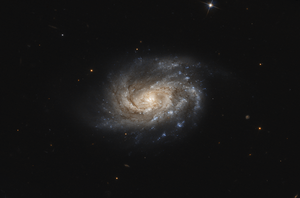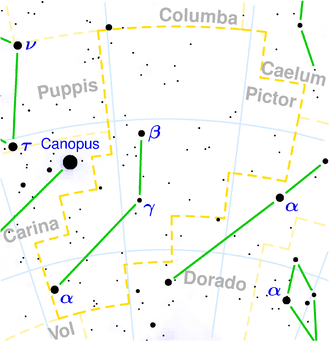NGC 1803
| Galaxy NGC 1803 |
|
|---|---|

|
|
| NGC 1803 ( Hubble Space Telescope ) | |
| AladinLite | |
| Constellation | painter |
|
Position equinox : J2000.0 , epoch : J2000.0 |
|
| Right ascension | 05 h 05 m 26.576 s |
| declination | -49 ° 34 ′ 04.64 ″ |
| Appearance | |
| Morphological type | Sbc: / HII |
| Brightness (visual) | 12.6 mag |
| Brightness (B-band) | 13.4 mag |
| Angular expansion | 1.3 ′ × 0.8 ′ |
| Position angle | 62 ° |
| Surface brightness | 12.5 mag / arcmin² |
| Physical data | |
| Redshift | 0.013626 ± 0.000017 |
| Radial velocity | 4085 ± 5 km / s |
|
Stroke distance v rad / H 0 |
(174 ± 12) · 10 6 ly (53.4 ± 3.7) Mpc |
| history | |
| discovery | John Herschel |
| Discovery date | December 28, 1834 |
| Catalog names | |
| NGC 1803 • PGC 16715 • ESO 203-018 • IRAS 05041-4938 • 2MASS J05052671-4934034 • GALEX ASC J050526.47-493404.7 | |
NGC 1803 is a spiral galaxy with extensive star formation regions of the Hubble type SBbc in the constellation Maler in the southern sky . It is estimated to be 174 million light years from the Milky Way and about 70,000 light years across . Together with PGC 16720 , it forms a gravitationally bound galaxy pair .
The object was discovered on December 28, 1834 by the astronomer John Herschel using his 18.7-inch play fee telescope and is therefore listed in the New General Catalog .
